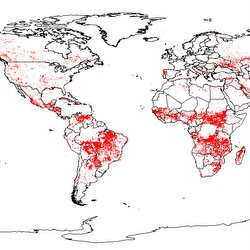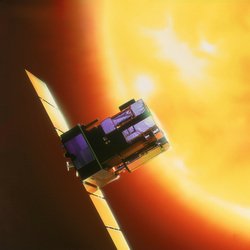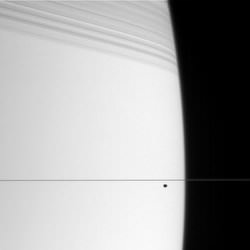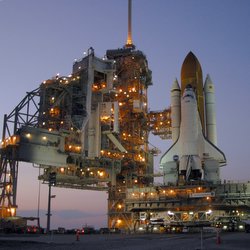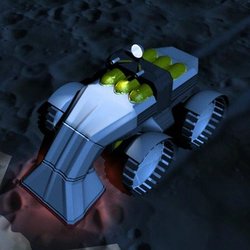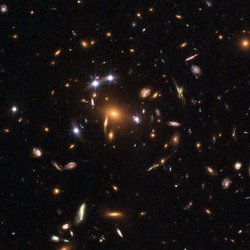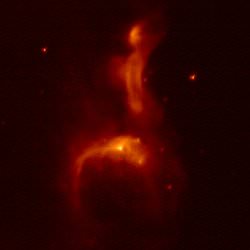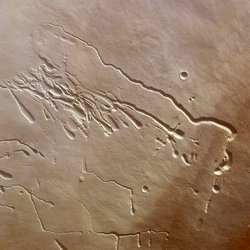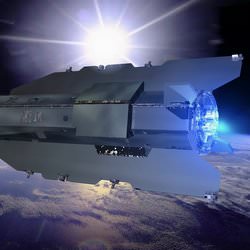
Artist illustration of the GOCE mission. Image credit: ESA. Click to enlarge
The European Space Agency has decided on the shortlist of spacecraft that could launch in less than a decade and contribute to the scientific exploration of our planet. The missions include Biomass, which will measure the Earth’s forests; TRAQ, which will monitor air quality; PREMIER, to watch how gasses change in the atmosphere; FLEX, to observe global photosynthesis; A-SCOPE, to track the global carbon cycle; and CoReH20, which will measure the ice/water/snow cycle. ESA requested proposals more than a year ago, and received 24 from different research groups.
ESA has announced the shortlist of new Earth Explorer mission proposals within its Living Planet Programme. This is part of the selection procedure that will eventually lead to the launch of the fourth Earth Explorer Core mission during the first half of the next decade.
The six missions cover a range of environmental issues with the aim of furthering our understanding of the Earth system and changing climate:
* BIOMASS – to take global measurements of forest biomass.
* TRAQ (TRopospheric composition and Air Quality) – to monitor air quality and long-range transport of air pollutants.
* PREMIER (PRocess Exploration through Measurements of Infrared and millimetre-wave Emitted Radiation) – to understand processes that link trace gases, radiation, chemistry and climate in the atmosphere.
* FLEX (FLuorescence EXplorer) – to observe global photosynthesis through the measurement of fluorescence.
* A-SCOPE (Advanced Space Carbon and Climate Observation of Planet Earth) – to improve our understanding of the global carbon cycle and regional carbon dioxide fluxes.
* CoReH2O (Cold Regions Hydrology High-resolution Observatory – to make detailed observations of key snow, ice and water cycle characteristics.
The selection of these six mission proposals follows the release of the Call for Earth Explorer Core mission ideas in March 2005. ESA received 24 responses, which covered a broad range of Earth science disciplines, and in particular responded well to the priorities set by the Agency’s Earth Science Advisory Committee (ESAC). These priorities focused on the global carbon and water cycles, atmospheric chemistry and climate, as well as the human element as a cross cutting issue.
The proposals were peer reviewed by scientific teams, and also appraised technically and programmatically. Based on these reviews, the ESAC evaluated the proposals and recommended the list of six mission ideas in order of priority. Following these recommendations, ESA’s Programme Board for Earth Observation on 18-19 May approved the proposal of the Director of Earth Observation Programmes to initiate assessment studies for these six mission candidates.
Earth Explorer Core missions are ESA-led research missions and the budget limit for the current set is 300 M€. The first Earth Explorer Core Missions were selected in 1999: the Earth Gravity field and Ocean Circulation (GOCE) mission and the Atmospheric Dynamics Mission (ADM-Aeolus) to be launched in 2007 and 2008 respectively. The third Core mission, Earth Clouds Aerosols and Radiation Explorer (EarthCARE), was selected in 2004 and will be launched in 2012.
In addition to the Earth Explorer Core missions, three Earth Explorer Opportunity missions are currently under implementation: SMOS for soil moisture and ocean salinity, CryoSat-2 for the study of ice sheets and sea ice, and Swarm, which is a constellation of small satellites to study the dynamics of the Earth’s magnetic field and its interactions with the Earth system, due for launch in 2007, 2009 and 2010, respectively.
The six mission candidates recently selected will significantly extend the scientific disciplines covered by ESA’s Living Planet Programme. When the assessment studies have been completed, a subset of the six candidates will be selected for feasibility study, and the mission finally selected for implementation will be launched during the first half of the next decade.
BIOMASS – the mission aims at global measurements of forest biomass. The measurement is accomplished by a space borne P-band synthetic aperture polarimetric radar. The technique is mainly based on the measurement of the cross-polar backscattering coefficient, from which forest biomass is directly retrieved. Use of multi-polarization measurements and of interferometry is also proposed to enhance the estimates. In line with the ESAC recommendations, the analysis for this mission will include comparative studies to measure terrestrial biomass using P- or L-band and consideration of alternative implementations using L-band.
TRAQ – the mission focuses on monitoring air quality and long-range transport of air pollutants. A new synergistic sensor concept allows for process studies, particularly with respect to aerosol-cloud interactions. The main issues are the rate of air quality change on regional and global scales, the strength and distribution of sources and sinks of tropospheric trace gases and aerosols influencing air quality, and the role of tropospheric composition in global change. The instrumentation consists of imaging spectrometers in the range from ultraviolet to short-wave infrared.
PREMIER – Many of the most important processes for prediction of climate change occur in the upper troposphere and lower stratosphere (UTLS). The objective is to understand the many processes that link trace gases, radiation, chemistry and climate in the atmosphere – concentrating on the processes in the UTLS region. By linking with MetOp/ National Polar-orbiting Operational Environmental Satellite System (NPOESS) data, the mission also aims to provide useful insights into processes occurring in the lower troposphere. The instrumentation consists of an infrared and a microwave radiometer.
FLEX – The main aim of the mission is global remote sensing of photosynthesis through the measurement of fluorescence. Photosynthesis by land vegetation is an important component of the global carbon cycle, and is closely linked to the hydrological cycle through transpiration. Currently there are no direct measurements available from satellites of this parameter. The main specification is for instruments to measure high spectral resolution reflectance and temperature, and to provide a multi-angular capability.
A-SCOPE – The mission aims to observe total column carbon dioxide with a nadir-looking pulsed carbon dioxide DIfferential Absorption Lidar (DIAL) for a better understanding of the global carbon cycle and regional carbon dioxide fluxes, as well as for the validation of greenhouse gas emission inventories. It will provide a spatially resolved global carbon budget combined with diagnostic model analysis through global and frequent observation of carbon dioxide. Spin-off products like aerosols, clouds and surface reflectivity are important parameters of the radiation balance of the Earth. A contribution to Numerical Weather Prediction is foreseen in connection with accurate temperature profiles. Investigations on plant stress and vitality will be supported by a fluorescence imaging spectrometer.
CoReH2O – The mission focuses on spatially detailed observations of key snow, ice, and water cycle characteristics necessary for understanding land surface, atmosphere and ocean processes and interactions by using two synthetic aperture radars at 9.6 and 17.2 GHz. It aims at closing the gaps in detailed information on snow glaciers, and surface water, with the objectives of improving modelling and prediction of water balance and streamflow for snow covered and glacierised basins, understanding and modelling the water and energy cycles in high latitudes, assessing and forecasting water supply from snow cover and glaciers, including the relation to climate change variability
Original Source: ESA News Release
